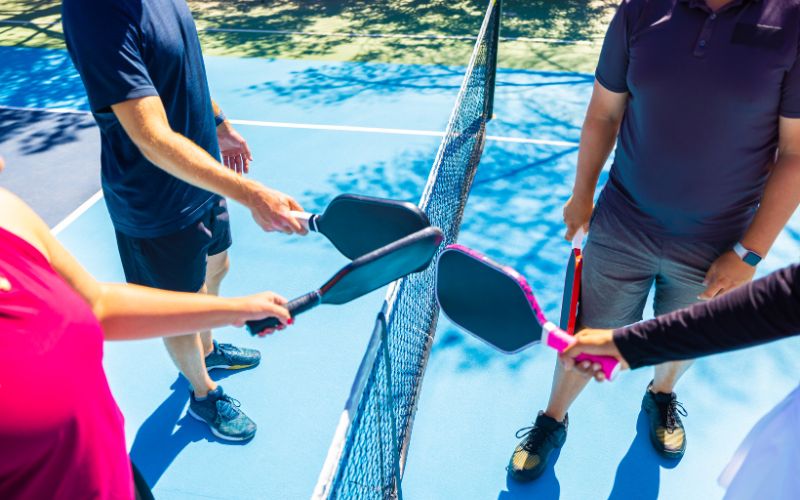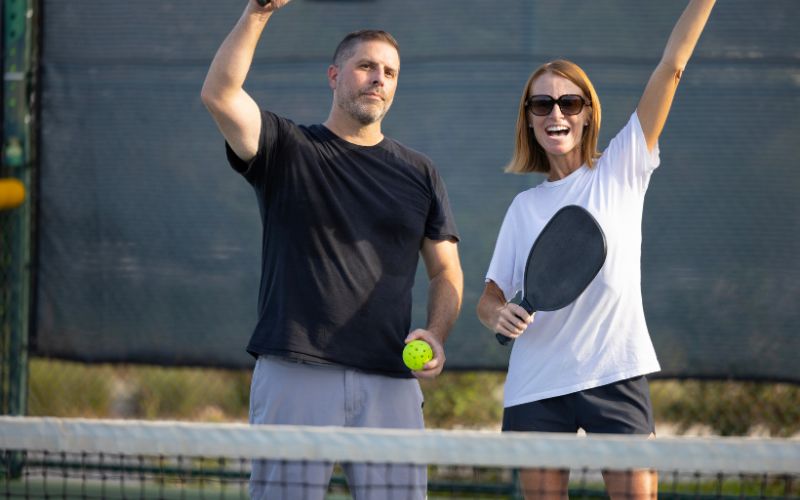Pickleball, a sport growing rapidly in popularity worldwide, revolves around its unique ball. Understanding what a pickle ball is made of is crucial for players to optimize their gameplay experience. From the materials used to the design intricacies, every aspect contributes to the dynamics of the game. Let’s delve into the composition of a pickleball, exploring its construction, variations, and impact on gameplay.
The Anatomy of a Pickleball Outdoor and Indoor Pickleball
Core Materials
At the heart of a pickleball lies its core, determining its bounce, flight, and overall performance. Pickleball cores are typically made of perforated plastic, featuring a multitude of small holes. These holes vary in size, affecting the ball’s aerodynamics and behavior during play. The perforations allow air to pass through, affecting the ball’s flight path and speed.
Outer Shell
The outer shell of a pickleball is crafted from a durable plastic material, designed to withstand the rigors of gameplay. This outer layer protects the core and contributes to the ball’s durability. Moreover, it influences the ball’s grip on different surfaces, ensuring consistent performance across various pickleball court surfaces.
Materials and Construction of Indoor and Outdoor Balls
Plastic Composition
Most pickleballs are made from synthetic materials like polyethylene or similar plastics. These materials offer durability, resilience, and consistent performance, essential for competitive play. The choice of materials ensures that the ball retains its shape and properties over numerous matches, providing players with a reliable tool for their game.
Hole Patterns
The number and size of the holes on a pickleball’s surface significantly impact its flight characteristics and responsiveness. Generally, pickleballs feature uniform hole patterns, although variations exist between manufacturers and ball types. These patterns influence the ball’s aerodynamics, determining its speed, trajectory, and bounce.
Pickleball ball Sizes and Weight
Pickleballs adhere to specific size and weight standards set by regulatory bodies like the USA Pickleball Association. The standard size ensures consistency across different balls, allowing players to adapt their techniques accordingly. Similarly, the weight of a pickleball affects its bounce and responsiveness on the court. Heavier balls may offer more stability in windy conditions, while lighter balls promote faster gameplay.
Indoor vs. Outdoor Pickleballs
Indoor and outdoor pickleball differ in several key aspects, including their design, performance characteristics, and suitability for specific playing environments. Understanding these differences can help players select the right pickleballs for their game and optimize their gameplay experience. Here’s a breakdown of the distinctions between indoor and outdoor pickleballs:
1. Design and Construction:
- Indoor Pickleballs: Indoor pickleballs are designed for controlled environments with smooth playing surfaces, such as gymnasiums or indoor pickleball court surfaces. They typically feature a smoother outer shell and uniform hole patterns to ensure consistent bounce and trajectory on indoor surfaces.
- Outdoor Pickleballs: Outdoor pickleball balls are engineered to withstand the rigors of outdoor game and challenging environmental conditions. They often have thicker walls and larger, more pronounced hole patterns compared to indoor balls. The robust construction of outdoor pickleballs enhances durability and resilience against wind, temperature fluctuations, and rough outdoor surfaces.
2. Material Composition:
- Indoor Pickleballs: Indoor pickleballs are usually made from synthetic materials like polyethylene or similar plastics. These materials prioritize smoothness and consistency, providing optimal performance on indoor courts.
- Outdoor Pickleballs: Outdoor pickleballs are crafted from durable plastic materials capable of withstanding exposure to UV rays, moisture, and outdoor elements. The materials used in outdoor pickleballs are engineered to maintain performance and integrity in various weather conditions.
3. Performance Characteristics:
- Indoor Pickleballs: Indoor pickleballs offer superior control and precision on smooth indoor surfaces. Their design promotes accurate shots and predictable bounce, allowing players to execute strategic maneuvers with confidence.
- Outdoor Pickleballs: Outdoor pickleballs are engineered to perform reliably in challenging outdoor environments. The larger holes and thicker walls of outdoor balls facilitate better wind resistance and stability, ensuring consistent flight and bounce during outdoor play.
4. Adaptability to Playing Conditions:
- Indoor Pickleballs: Indoor pickleballs are optimized for consistent playing conditions, making them suitable for competitive play in indoor venues. They are less affected by external factors like wind and temperature variations, allowing players to focus on their game without significant environmental interference.
- Outdoor Pickleballs: Outdoor pickleballs are specifically designed to accommodate the unpredictable nature of outdoor play. Their robust construction and aerodynamic design make them well-suited for windy conditions and rough outdoor surfaces. Outdoor pickleballs provide reliable performance across a wide range of outdoor courts playing environments.
Pickleball Ball Variations
Specialized Designs
In addition to standard pickleballs, manufacturers produce specialized variants tailored to specific playing conditions and preferences. Wiffle balls, for instance, feature larger holes and softer materials, promoting a slower pace and gentler impact. These balls are ideal for beginners and casual players looking to refine their skills without the intensity of regulation pickleball balls.
Color and Visibility
Pickleballs come in a variety of colors, allowing players to customize their equipment and enhance visibility on the court. While uniform color schemes are common for official competitions, recreational players may opt for vibrant hues to improve tracking and visibility during gameplay. Personal preference and playing environment dictate the choice of ball color, ensuring optimal visibility and performance.
Conclusion
In summary, understanding what a pickleball is made of provides valuable insight into the intricacies of this relatively new sport. From the core materials to the outer shell design, every component influences the ball’s performance and behavior on the court. Whether playing indoors or outdoors, selecting the right pickleball ensures an enjoyable and competitive experience for players of all skill levels. As the sport continues to evolve, innovations in pickleball ball technology promise to enhance gameplay dynamics and elevate the playing experience for enthusiasts worldwide.
Frequently Asked Questions (FAQs) About Pickleball Balls
1. What are pickleballs made of?
Pickleballs are primarily made of synthetic materials, typically polyethylene or similar plastics. These materials offer durability, resilience, and consistent performance essential for competitive play. The core of a pickleball is usually perforated plastic, featuring small holes that affect the ball’s aerodynamics during gameplay.
2. How do hole patterns affect pickleball performance?
The hole patterns on a pickleball’s surface significantly impact its flight characteristics and responsiveness. While most pickleballs feature uniform hole patterns, variations exist between manufacturers and ball types. These patterns influence the ball’s aerodynamics, determining its speed, trajectory, and bounce on the court.
3. What is the difference between indoor and outdoor pickleballs?
Indoor pickleballs prioritize smoothness and consistency, ideal for controlled environments with stable conditions. They offer superior control and precision on smooth courts. On the other hand, outdoor pickleballs are designed to withstand harsh conditions, featuring thicker walls and larger holes to mitigate wind and temperature variations.
4. Can I use the same pickleball indoors and outdoors?
While it’s possible to use the same pickleball indoors and outdoors, it’s generally recommended to choose the appropriate ball for the specific playing environment. Indoor balls perform better on smooth surfaces, while outdoor balls are designed for challenging outdoor conditions. Using the right ball ensures optimal performance and gameplay experience.
5. How do pickleball ball variations impact gameplay?
Pickleball ball variations, such as wiffle balls and specialized designs, offer players options tailored to specific playing conditions and preferences. Wiffle balls, for instance, feature larger holes and softer materials, promoting a slower pace and gentler impact ideal for beginners and casual players. Understanding these variations allows players to adapt their playing style and optimize their performance on the court.






